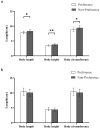Sex Differences in Mate Choice Preference Characteristics of Aequidens rivulatus
- PMID: 35565631
- PMCID: PMC9101118
- DOI: 10.3390/ani12091205
Sex Differences in Mate Choice Preference Characteristics of Aequidens rivulatus
Abstract
The mating roles of males and females, to a certain extent, are dynamic and variable. Several factors influence the mate choice process. Nonetheless, the main preference features have not yet been fully understood in Aequidens rivulatus. In this study, because of its natural pairing characteristics, A. rivulatus was selected to explore the mate choice preferences of different sexes. Specifically, male and female behavioral performances were described and quantified through a "no-choice paradigm" during mate choice. A total of 12 behavioral performances were defined in male mate choice (experiment 1), whereas 14 behavioral performances were defined in female mate choice (experiment 2). According to the obtained results, unselected females did not display any proactive behaviors in experiment 1, whereas unselected males exhibited proactive behaviors in experiment 2, including quivering, nipping, tail beating, swimming up and down, and aggression. It was also found that both male and female individuals tend to express dislike rather than like. Those behaviors with higher frequencies (e.g., quivering) often mean less energy expenditure, thus easier repeatability. Moreover, principal component analysis (PCA) was employed to extract and identify mate choice preference features. Preliminary results indicated that male preferences for a mate were mainly associated with body size, behavioral intention, and appearance, whereas the intensity of female preferences was in the order of body size, appearance, and behavioral intention. In addition, sex hormone levels were associated with mate choices.
Keywords: Aequidens rivulatus; mate choice; mate preferences; no-choice test; sex differences; sex selection.
Conflict of interest statement
The authors declare that they have no known competing financial interests or personal relationships that could have appeared to influence the work reported in this paper.
Figures





Similar articles
-
Variation in mate choice and mating preferences: a review of causes and consequences.Biol Rev Camb Philos Soc. 1997 May;72(2):283-327. doi: 10.1017/s0006323196005014. Biol Rev Camb Philos Soc. 1997. PMID: 9155244 Review.
-
The evolution of male mate choice in insects: a synthesis of ideas and evidence.Biol Rev Camb Philos Soc. 2001 Aug;76(3):305-39. doi: 10.1017/s1464793101005693. Biol Rev Camb Philos Soc. 2001. PMID: 11569787 Review.
-
Personality differentially affects individual mate choice decisions in female and male Western mosquitofish (Gambusia affinis).PLoS One. 2018 May 15;13(5):e0197197. doi: 10.1371/journal.pone.0197197. eCollection 2018. PLoS One. 2018. PMID: 29763435 Free PMC article.
-
Mate choice in adult female Bengalese finches: females express consistent preferences for individual males and prefer female-directed song performances.PLoS One. 2014 Feb 18;9(2):e89438. doi: 10.1371/journal.pone.0089438. eCollection 2014. PLoS One. 2014. PMID: 24558501 Free PMC article.
-
Mate choice and mate competition influence male body size in Japanese medaka.Anim Behav. 1998 May;55(5):1151-63. doi: 10.1006/anbe.1997.0682. Anim Behav. 1998. PMID: 9632501
References
-
- Andersson M. Sexual Selection. PU Press; Princeton, NJ, USA: 1994.
-
- Robert T. Parental Investment and Sexual Selection. Sexual Selection and the Descent of Man Aldine de Gruyter; New York, NY, USA: 1972. pp. 136–179.
-
- Williams G.C. Sex and Evolution. PU Press; Princeton, NJ, USA: 1975.
Grants and funding
LinkOut - more resources
Full Text Sources

